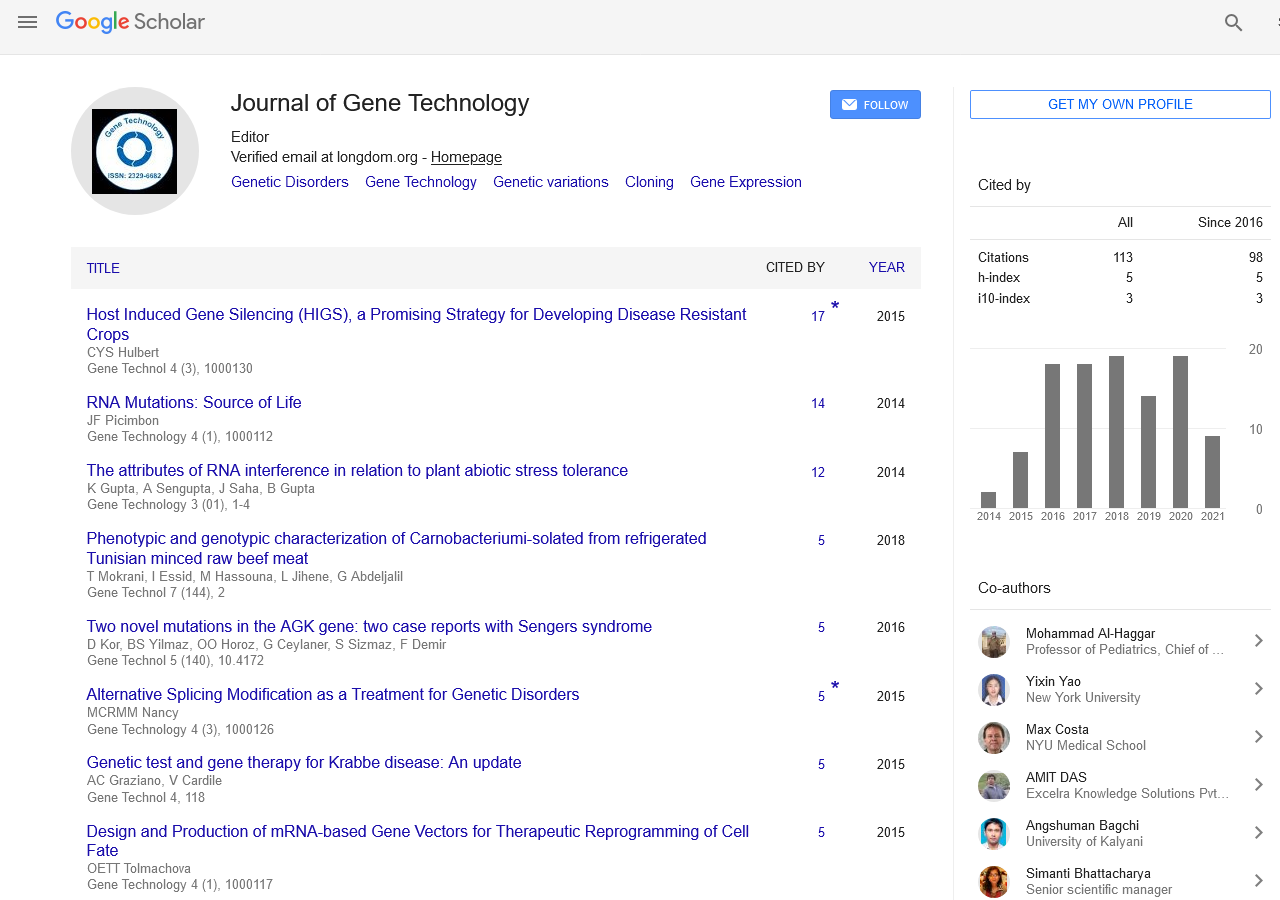PMC/PubMed Indexed Articles
Indexed In
- Academic Keys
- ResearchBible
- CiteFactor
- Access to Global Online Research in Agriculture (AGORA)
- RefSeek
- Hamdard University
- EBSCO A-Z
- OCLC- WorldCat
- Publons
- Euro Pub
- Google Scholar
Useful Links
Share This Page
Journal Flyer

Open Access Journals
- Agri and Aquaculture
- Biochemistry
- Bioinformatics & Systems Biology
- Business & Management
- Chemistry
- Clinical Sciences
- Engineering
- Food & Nutrition
- General Science
- Genetics & Molecular Biology
- Immunology & Microbiology
- Medical Sciences
- Neuroscience & Psychology
- Nursing & Health Care
- Pharmaceutical Sciences
Commentary Article - (2023) Volume 12, Issue 5
Gene Response to Stress: Exploration of R2R3-MYB Family Genes Across the Ginger Genome
Fattah Elfeky*Received: 02-Oct-2023, Manuscript No. RDT-23-23704; Editor assigned: 05-Oct-2023, Pre QC No. RDT-23-23704(PQ); Reviewed: 19-Oct-2023, QC No. RDT-23-23704; Revised: 26-Oct-2023, Manuscript No. RDT-23-23704(R); Published: 02-Nov-2023, DOI: 10.35248/2329-6682.23.12.252
Description
Plants being sessile organisms have evolved intricate molecular mechanisms with a wide range of environmental stresses. Among the many gene families involved in plant stress responses, the R2R3-MYB transcription factors play a important role. These transcription factors are known for their ability to regulate gene expression in response to various stressors, thereby helping plants adapt to adverse conditions. This article delves into the exploration of the R2R3-MYB gene family across the ginger genome and its implications for understanding the stress responses in this valuable plant. The R2R3-MYB transcription factors are part of a larger family of MYB proteins, which are characterized by the presence of the MYB DNA-binding domain. The R2R3-MYB proteins are distinguished by having two MYB domains, typically R2R3, which contribute to their diverse functions. These proteins are key players in the regulation of various biological processes, including plant development, secondary metabolism, and stress responses. Plant stress responses, R2R3-MYB transcription factors have been found to regulate the expression of stress-responsive genes, leading to the activation of protective mechanisms. They do so by binding to the promoter regions of target genes involved in stress tolerance, ultimately contributing to the plant's ability to survive and adapt under adverse environmental conditions.
Ginger a widely cultivated spice and medicinal plant, belongs to the Zingiberaceae family and is valued for its rhizomes, which are rich in bioactive compounds. In addition to its economic importance, ginger has been used traditionally for its medicinal properties such as anti-inflammatory, antioxidant, and anti- microbial effects. Understanding the genetic basis of ginger's stress responses can have significant implications for both its cultivation and its potential application in stress-related and development. Ginger is exposed to various environmental stress factors during its growth, including drought, salinity, temperature fluctuations, and pathogenic attacks. To adapt to these stressors, ginger employs a variety of molecular mechanisms, including the regulation of stress-responsive genes.
The R2R3-MYB transcription factors, being pivotal regulators in stress responses, are a promising target for investigation in the ginger genome. The R2R3-MYB gene families in the ginger genome employ a variety of bioinformatics tools and techniques. These tools help identify and characterize R2R3-MYB genes based on the conserved MYB domains. The ginger genome is sequenced and annotated, providing valuable information for gene discovery and analysis. One of the critical steps in this exploration is phylogenetic analysis, which allows classifying ginger R2R3-MYB genes into different subgroups based on their sequence similarity to known R2R3-MYB proteins from other plant species. This analysis can shed light on the evolutionary relationships and potential functional roles of these genes in ginger's stress responses.
The discovery and characterization of R2R3-MYB genes in the ginger genome offer valuable insights into the plant's stress responses. By identifying specific R2R3-MYB genes that are upregulated in response to different stressors, can gain a better understanding of the regulatory networks involved in stress tolerance. This knowledge can be harnessed to develop strategies for improving ginger cultivation under adverse conditions. Furthermore, ginger R2R3-MYB genes may serve as targets for genetic engineering to enhance stress tolerance in other plant species. Transgenic approaches can be employed to introduce ginger R2R3-MYB genes into crops with economic and ecological significance, contributing to the development of stress-resistant cultivars. The bioactive compounds present in ginger, including gingerol and zingerone, are known for their antioxidant and anti-inflammatory properties. Understanding the molecular mechanisms underlying their biosynthesis, which is likely regulated by R2R3-MYB transcription factors, can lead to the development of stress-responsive ginger cultivars with enhanced bioactive compound content.
The exploration of the R2R3-MYB gene family across the ginger genome holds great promise for understanding the plant's stress responses. Ginger, a valuable crop with traditional medicinal uses, faces a range of environmental stressors during its growth. The identification and characterization of R2R3-MYB genes in ginger can provide critical insights into the regulatory mechanisms that enable this plant to adapt and thrive under adverse conditions. The genetic basis of ginger's stress responses can not only improve the cultivation of this economically important crop but also apply the knowledge gained to enhance stress tolerance in other plant species. Furthermore, the potential role of R2R3-MYB transcription factors in the biosynthesis of bioactive compounds in ginger highlights the multifaceted implications. In the future, the findings from the exploration of R2R3-MYB genes in the ginger genome may contribute to agricultural advancements and innovations in the field of natural products and medicinal plant.
Citation: Elfeky F (2023) Gene Response to Stress: Exploration of R2R3-MYB Family Genes across the Ginger Genome. Gene Technol. 11:252.
Copyright: © 2023 Elfeky F. This is an open-access article distributed under the terms of the Creative Commons Attribution License, which permits unrestricted use, distribution, and reproduction in any medium, provided the original author and source are credited.


